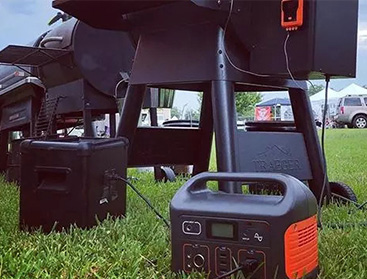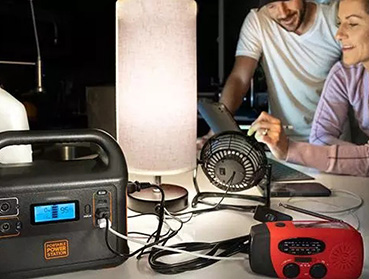BESS for Portable Power

Power Bank
A portable power station is an essential piece of equipment to keep important devices like medical equipment, radios, appliances, and smartphones charged and running during emergencies and power outages. It has both standard AC outlets and USB ports for powering multiple types of devices at once.
How a portable power station work
Portable power stations can be a lifesaver in many situations. Whether you find yourself in a blackout with no backups or need to charge up some electronics while camping, this is an essential item for camping and home. We look at how portable power stations work and how to pick the best one fit for purpose.
A portable power station’s main component is a rechargeable battery. This battery stores charge and release it in DC form or AC form via its outputs. The outputs can include AC, USB, or Cigarette lighter plugs. A power station can be charged with either an AC charger or using solar panels. They are also referred to as solar generators.
To understand how it works we need to look at these components.
Components of a Power Station
A power station is made up of different components. The main component is the battery with all the other components supporting functions either to charge the battery or power devices from the battery.
Battery
As stated before the main component of the power station is the rechargeable battery. Portable power stations were first created for miners who work in deep trenches and were made from Lead-acid batteries. Lead-acid batteries are cheaper but heavier and do not last as long. Modern power stations consist mainly of lithium-ion batteries which are more stable, lighter, and can be recharged quicker and easier.
Inverters
Power in the battery is stored in the form of DC power. In order to use power from to power AC appliances which is most of the appliances in our homes like TVs, laptops or blenders you need to convert the power to AC power.
A power station will need an Inverters to convert DC power from a battery to AC current for household use. Inverters come in many different sizes and shapes, as well as with different features to suit their specific use. So the type and size of inverter in the power station will determine what devices it can power.

Power BBQ

Power RV Life

Power Emergency
Why we need a portable power station
A portable power station is an essential piece of equipment to keep important devices like medical equipment, radios, appliances, and smartphones charged and running during emergencies and power outages. Many power stations have both standard AC outlets and USB ports for powering multiple types of devices at once. Portable power stations have an advantage over traditional generators, in that they don't require gasoline, kerosene, or propane to run. This not only saves you money and time spent on engine maintenance, it makes battery backups much, much safer to use indoors or outdoor.
Power stations also give you a wider range of power output options than traditional generators. If you just want to keep your phone charged and a radio running, there are handheld inverters available.
Best extreme weather tech: Power outage gear
Portable power stations are also quieter than traditional generators, letting you hear important updates more easily, and feature push-button starts and instant-on abilities; no more struggling with pull-starts and warm-up cycles. If you want a more in-depth explanation of the differences between portable power stations and traditional generators, you can read our special feature, which covers everything from cost and energy needs to how weather and even earthquakes affect your emergency power options. You can also check out our list of the best home generators for whole-home emergency power.
The easy-to-read LCD display lets you quickly see how much power the generator has left, and you can purchase solar panels for more eco-friendly recharging; the solar panels are also great for steady power during summer storm outages. A one-button push start gives you instant electricity, and being battery powered means you don't have to worry about keeping the battery pack fueled up or venting harmful exhaust.
What's the difference between a battery backup and a generator?
A generator is typically used to restore power to your entire home, or at least most of your home, for as long as you have fuel to power the generator. A battery backup doesn't have the same energy capacity, and is best used to keep essential equipment like CPAP machines, sump pumps, and space heaters running until power is restored. Battery backup systems also don't need kerosene, gasoline, or propane to run, making them much safer to use indoors and a bit more cost-efficient to run; this also means you don't have to worry about engine maintenance.
How long will a battery backup last?
That depends on the backup unit's power capacity and how many devices you have connected to it. Lower wattage units will only give you up to about 10 hours of emergency power, while higher wattage units may give you several days worth of electricity. Many newer battery backup systems allow for charging via solar panels, giving you continuous charging options during lengthy power outages.
How big of a battery backup do I need?
The best way to determine your emergency power needs is to make a definite list of devices you'd want to keep running during an outage. Do you just want to keep your phones charged and a radio powered on to hear weather alerts? You should opt for a low-wattage backup. Do you need to run medical equipment, standard appliances, or a pellet stove? It's better to invest in a much higher wattage backup system.
Once you have a list of devices, add up their voltage and wattage; that number is how much output your battery backup system should have, at minimum. It's better to have a backup that gives you a bit more juice than you need than one that struggles to keep up.

 English
English Português
Português 日本語
日本語 Español
Español Pусский
Pусский Deutsch
Deutsch 한국어
한국어 العربية
العربية Français
Français Tiếng Việt
Tiếng Việt Italiano
Italiano